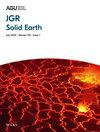流体压力和粘性流变如何影响低角度正断层的滑动模式:以意大利亚平宁山脉北部Altotiberina断层为例
IF 4.1
2区 地球科学
Q1 GEOCHEMISTRY & GEOPHYSICS
引用次数: 0
摘要
低角度正断层是一种机械异常,尽管其倾角小于30°,但仍存在正常意义上的滑动,这与安德森的预测相违背。这种断层上的滑动可归因于超压流体或低摩擦矿物。这种断层的一个例子是意大利中部的阿尔托蒂贝里纳断层(ATF)。ATF上盘被许多地震活动的高角度正断层切割,这些正断层被称为隆起。沿ATF的活动滑动表现为集中在深度5公里的无数次小地震(ML < 2),以及可能较浅的罕见破坏性地震。在该地区已经记录了超压,深层来源的二氧化碳和具有粘性岩性的复杂机械地层。为了更好地理解流体压力、流变学和地震模式之间的关系,我们使用矿化、地震和流体流动集成模拟器(MEFISTO)整合了这些过程。该数值模型模拟了流体压力、孔隙度、渗透率和断层强度同时变化的地震。我们研究了沿ATF断裂带的凸起(可作为限压液压阀或流体流动屏障)和压力溶解蠕变的综合影响。模式结果再现了观测到的地震活动模式的显著特征。向上传播的流体压力波产生地震活动的瞬态簇。然而,大的、浅的、因此具有潜在破坏性的地震通常不是由流体压力波直接引发的,这限制了流体压力波作为灾害预测工具的效用。本文章由计算机程序翻译,如有差异,请以英文原文为准。
How Fluid Pressures and Viscous Rheologies Affect Slip Patterns on Low‐Angle Normal Faults: The Example of the Altotiberina Fault, Northern Apennines, Italy
Low‐angle normal faults are a mechanical anomaly, hosting normal‐sense slip despite having a dip shallower than 30°, in contravention of Andersonian prediction. Slip on such faults has been attributed to overpressurized fluids or low‐friction minerals. An example of such a fault is the Altotiberina Fault (ATF) in central Italy. The ATF hanging wall is cut by numerous seismically active, high‐angle normal faults called epidetachments. Active slip along the ATF manifests in myriad small (M L 2 and a complex mechanical stratigraphy with viscous lithologies. To better understand the relationship between fluid pressure, rheology, and earthquake patterns, we integrate these processes using the Mineralization, Earthquake, and Fluid‐flow Integrated SimulaTOr (MEFISTO). This numerical model simulates earthquakes with simultaneous changes in fluid pressure, porosity, permeability, and fault strength. We investigated the combined effects of epidetachments, which can serve as either pressure‐limiting hydraulic valves or fluid‐flow barriers, and pressure‐solution creep along the ATF fault‐zone. Model results reproduce salient features of the observed seismicity pattern. Upward‐propagating fluid‐pressure waves generate transient clusters of seismic activity. However, large, shallow–and therefore potentially damaging–earthquakes occur that are often not directly triggered by fluid‐pressure waves, limiting the waves' utility as hazard predictors.
求助全文
通过发布文献求助,成功后即可免费获取论文全文。
去求助
来源期刊

Journal of Geophysical Research: Solid Earth
Earth and Planetary Sciences-Geophysics
CiteScore
7.50
自引率
15.40%
发文量
559
期刊介绍:
The Journal of Geophysical Research: Solid Earth serves as the premier publication for the breadth of solid Earth geophysics including (in alphabetical order): electromagnetic methods; exploration geophysics; geodesy and gravity; geodynamics, rheology, and plate kinematics; geomagnetism and paleomagnetism; hydrogeophysics; Instruments, techniques, and models; solid Earth interactions with the cryosphere, atmosphere, oceans, and climate; marine geology and geophysics; natural and anthropogenic hazards; near surface geophysics; petrology, geochemistry, and mineralogy; planet Earth physics and chemistry; rock mechanics and deformation; seismology; tectonophysics; and volcanology.
JGR: Solid Earth has long distinguished itself as the venue for publication of Research Articles backed solidly by data and as well as presenting theoretical and numerical developments with broad applications. Research Articles published in JGR: Solid Earth have had long-term impacts in their fields.
JGR: Solid Earth provides a venue for special issues and special themes based on conferences, workshops, and community initiatives. JGR: Solid Earth also publishes Commentaries on research and emerging trends in the field; these are commissioned by the editors, and suggestion are welcome.
 求助内容:
求助内容: 应助结果提醒方式:
应助结果提醒方式:


